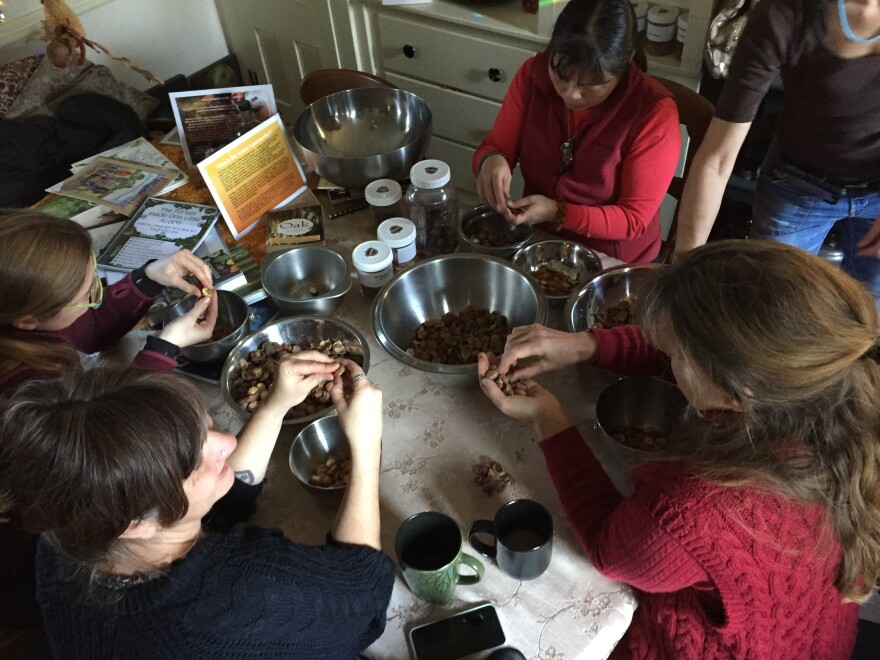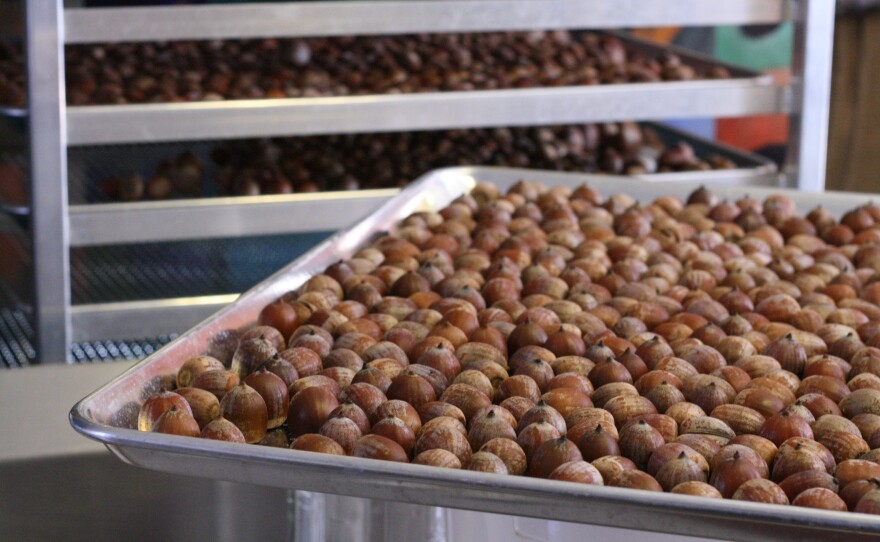I’m standing in a barn in Stoughton, Massachusetts, just south of Boston I’m at a workshop with the New England Acorn Cooperative. Five women are gathered around a machine called the Davebilt Nutcracker, where three young boys are churning out cracked acorns.
Daniela Dana started the acorn cooperative.
“Acorn cracking is really dirty business because you have to wait until the nuts are dry, so it makes it dusty.”
She first learned that acorns are edible through a book that described how indigenous cultures around the world used the nuts as a staple food — like wheat or corn for flour today. Soon after, she traveled to Greece to learn how to process acorns. Like olives, acorns are bitter and don’t taste good straight off the tree. The women and kids gathered in the barn today are here to learn about processing.
“The ones that you guys just cracked are dried from last year. And one of the neat things about acorns is that they can store for a number of years if you leave them in the shell, because of all that tannin they store very nicely,” said Daniela.
The tannin Daniela’s talking about is tannic acid, which is the same compound that’s found in red wine, unripe fruit, and tea, and tannins act as a preservative that can keep acorns fresh for up to a decade.
“When we gather, because there are a couple very common pests, acorn weevil being one of them, and because weevils land and lay an egg very early in the season acorns can look perfect but are full of bugs, so we always teach before you gather a whole bunch of acorns you should smash a few and look and see what the level of infestation is.”
The weevils look like little white worms — they eat the meat inside the nut and discolor it, and you’ll see an exit hole if they’ve left. Another telltale sign of infestation is if the caps don’t pop off easily. Once the acorns are dried and cracked, the meats have to be picked from the shells. A woman named Soula, who’s here for the first time, says out loud what I’m thinking:
“It looks like it’s going to take a lot of time to sort it out.”

Daniela explained that it’s a process to do with friends. Acorn gathering and processing is very communal.
The women sit down and begin sorting the shells and meats into bowls. They chat and get to know each other as they work. Soula is originally from Taiwan and has been reading up about eating acorns online. Babette is here to learn for the Boston Food Forest Coalition, and Jasmine and Teresa come to Coop events with their kids. After an hour or so, the women have enough meats picked out to start the leaching process. This involves soaking the ground acorns in cold water to get out the tannins. Babette says how long you have to soak the acorns can vary.
“I think it depends on the nut. So these are pretty sweet nuts from this set of trees so they only take like 5 or 6 days but I collected ones last year they needed like 2 weeks.”
To leach you strain the water off every day and add new cold water. This can be done at room temperature, although some people say theirs start to ferment and prefer the fridge. You can tell the leaching process is done when the water no longer turns brown and the acorn meal losses its astringency.

“After you’ve leached it you can strain and freeze it, and then cook with it wet,” said Daniela.
This basically makes acorn grits—bigger chunks good for things like pudding or coarse breads or roasting. If you want acorn flour, though, you have to dry the grits and then grind them into a powder. Daniela says she uses a milling attachment for this on her Kitchen Aid, but that it can also be done with a coffee grinder.
“Coffee grinders are pretty rugged, and acorn grits require about that amount of force as coffee beans to make into a powder.” She added, “but if you run it through a coffee grinder it’s really important to use a sifter, and then you get your flour.”
Acorn flour is something most of us have never heard of. And yet, historically and to this day in some places, acorns sustain people. There are over 600 varieties of oak trees worldwide—an incredible abundance. Suddenly I’m looking out at our forest of scarlet, black, and white oaks and seeing food.
--
Find out more about the New England Acorn Cooperative here.
This piece first aired in November 2019.










